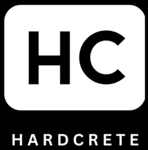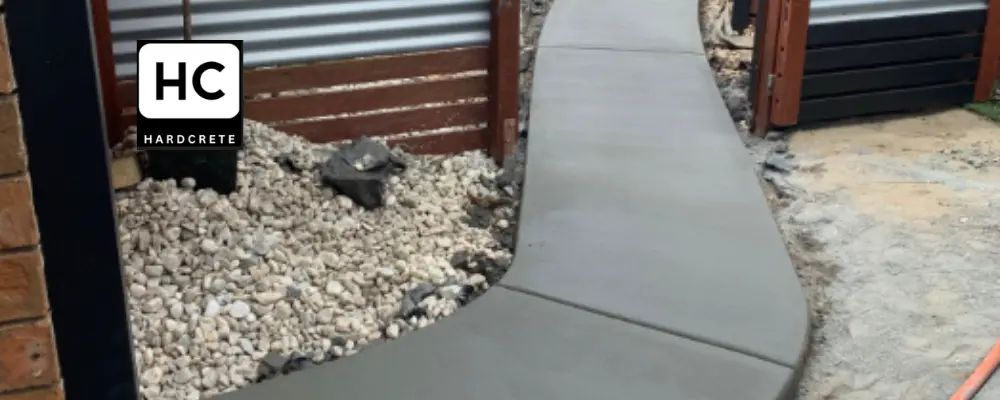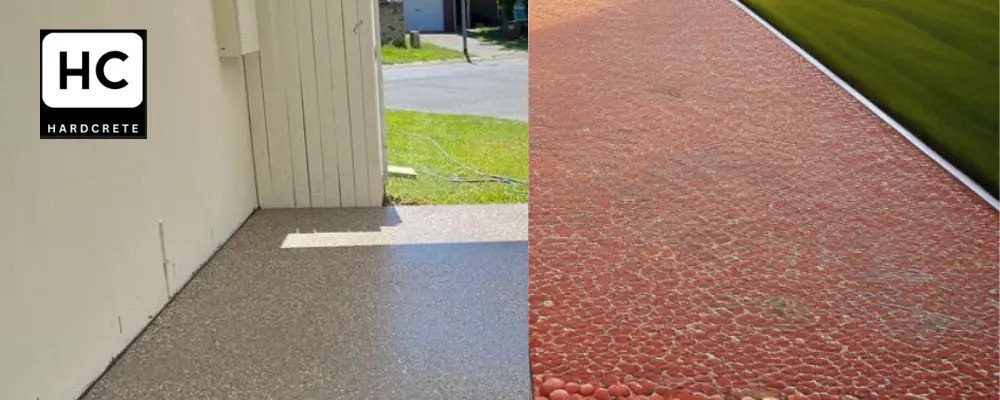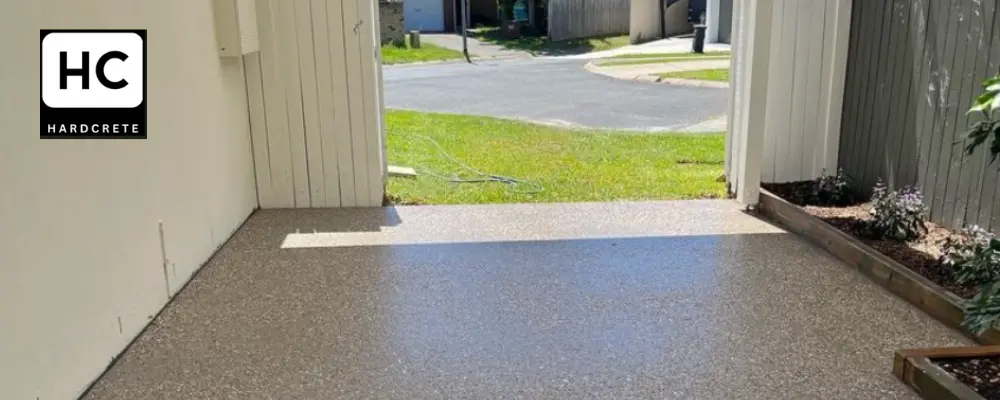Key Highlights
- Both plain concrete and exposed aggregate are strong, long-lasting, and cost-effective options for your Melbourne home.
- Plain concrete is a durable and clean-looking finish, while exposed aggregate offers a wide variety of design options.
- Plain concrete requires very little maintenance and can withstand Melbourne’s extreme weather conditions.
- Exposed aggregate may require more maintenance due to its textured surface.
- Plain concrete is generally cheaper than exposed aggregate, but the choice depends on your specific needs and preferences.
- Consider the aesthetic appeal, durability, maintenance needs, and cost when choosing between plain concrete and exposed aggregate.

Introduction
When it comes to choosing the right type of concrete for your Gold Coast home, the decision between plain concrete and exposed aggregate can be a tough one. Both options have their own unique characteristics and benefits, making it important to understand the differences before making a choice.
Plain concrete is a traditional and durable finish that provides a clean and uniform look to your driveway, patio, or slab. It is made up of a mixture of cement, aggregate, and water, and is poured in place and smoothed out for a smooth, grey surface. On the other hand, exposed aggregate offers a more decorative and textured look, with a top layer that is removed to reveal the embedded aggregate beneath.
In this guide, we will delve into the nuances of plain concrete and exposed aggregate, exploring their definition, composition, installation process, aesthetic appeal, durability, maintenance needs, cost considerations, and environmental impact. By the end, you will have a comprehensive understanding of both options, allowing you to make an informed decision that best suits your needs and preferences.
So, let’s dive in and settle the debate between plain concrete and exposed aggregate once and for all!
Understanding Plain Concrete and Exposed Aggregate
Before we delve into the details, let’s understand what plain concrete and exposed aggregate concrete actually mean.
Plain concrete, also known as standard concrete or concrete surface, is a type of concrete that provides a smooth and uniform finish. It is commonly used in construction due to its strength and durability. On the other hand, exposed aggregate concrete is a type of concrete where the top layer is removed to expose the embedded aggregate, such as small stones or pebbles. This gives the concrete a textured and decorative appearance.
Both plain concrete and exposed aggregate concrete have their own unique characteristics and advantages, which we will explore in the following sections. So, let’s dig deeper into the definition and basic composition of these two types of concrete.
Definition and Basic Composition
Plain concrete, also known as standard concrete or concrete surface, is a commonly used construction material due to its versatility and durability. It is made by mixing cement, aggregate (such as sand or gravel), and water. The proportions of these ingredients may vary depending on the specific application and desired strength of the concrete.
The basic composition of plain concrete typically consists of cement, which acts as a binder, and aggregate, which provides the bulk and strength to the concrete. Water is added to the mixture to initiate the chemical reaction that causes the concrete to harden and gain its strength.
Standard concrete is classified into different grades based on its strength and composition. The most common grade used in construction is known as normal class concrete, which has a compressive strength ranging from 20 to 40 megapascals (MPa). This type of concrete is suitable for various applications, including driveways, pathways, and slabs.
Now that we have a basic understanding of plain concrete, let’s explore its historical background and evolution.
Historical Background and Evolution
Concrete has been used as a construction material for thousands of years, with evidence of its use dating back to ancient civilizations such as the Egyptians and Romans. However, the use of plain concrete as we know it today has evolved over time.
In the early days, concrete was primarily made from a mixture of lime, sand, and water, known as lime concrete. This type of concrete was widely used in ancient structures due to its ability to harden and withstand the test of time.
Over the years, advancements in technology and the discovery of cement as a binding agent led to the development of modern concrete. The introduction of reinforced concrete, which includes the addition of steel bars or mesh within the concrete, further enhanced its strength and durability.
Today, plain concrete is one of the most widely used construction materials, thanks to its affordability, versatility, and long-lasting properties. With the advent of new techniques and materials, such as exposed aggregate, homeowners now have more options to choose from when it comes to concrete finishes.
Now that we have explored the historical background and evolution of concrete, let’s move on to the installation process and compare the installation steps for plain concrete and exposed aggregate.
The Installation Process Compared: plain concrete vs exposed aggregate
Installing a new concrete driveway, patio, or slab involves a series of steps to ensure a strong and durable result. While the installation process for plain concrete and exposed aggregate is similar in some aspects, there are key differences to consider.
The installation process for plain concrete involves preparing the site, pouring the concrete mixture in place, and smoothing it out to achieve a uniform finish. The concrete is then left to cure and harden before it can be used.
On the other hand, the installation process for exposed aggregate concrete involves a few additional steps. After pouring the concrete, a special chemical is sprayed on the surface to prevent the top layer from hardening. This wet surface is then protected for a certain period, typically 24 hours, before the top layer of concrete is removed using a power-washer. This exposes the aggregate beneath and gives the concrete its textured appearance.
Now that we understand the installation process for both types of concrete, let’s delve into the specific steps involved in installing plain concrete and the key differences in exposing aggregate.
Steps in Installing Plain Concrete
Installing plain concrete involves a series of steps to ensure a smooth and durable finish. The process begins with site preparation, including excavation and leveling of the area where the concrete will be poured. This is followed by the construction of formwork to contain the concrete and give it the desired shape.
Once the formwork is in place, the concrete mixture is poured into the designated area. The concrete is then spread and leveled using tools such as a screed or trowel to achieve a uniform surface. After the concrete has been leveled, it is left to cure and harden for a specified period, typically a few days, depending on the weather conditions.
Once the concrete has fully cured, any necessary finishing touches, such as sealing or staining, can be applied to enhance its appearance and protect it from the elements. With proper maintenance and care, a plain concrete finish can last for several decades, providing a durable and functional surface for your driveway, patio, or slab.
Now that we understand the installation process for plain concrete, let’s explore the key differences in exposing aggregate for an exposed aggregate finish.
Key Differences in Exposing Aggregate
The process of exposing aggregate in concrete involves removing the top layer of concrete to reveal the embedded aggregate, such as small stones or pebbles, beneath. This gives the concrete a textured appearance and enhances its aesthetic appeal.
One key difference in the installation process for exposed aggregate is the use of a special chemical that is sprayed on the surface of the concrete after it has been poured. This chemical prevents the top layer of concrete from hardening, allowing it to be removed at a later stage.
After the wet surface has been protected for a specific period, typically 24 hours, the top layer of concrete is removed using a power-washer. This exposes the aggregate beneath and creates a textured surface. The size and type of aggregate used can vary depending on the desired look and design preferences.
The process of exposing aggregate requires skill and precision to ensure a consistent and visually appealing finish. With the right techniques and materials, an exposed aggregate concrete driveway, patio, or pathway can transform your outdoor space into a visually stunning and decorative area.
Now that we have explored the installation process and key differences in exposing aggregate, let’s move on to the aesthetic appeal and design flexibility of plain concrete and exposed aggregate.
Aesthetic Appeal and Design Flexibility
The aesthetic appeal and design flexibility of a concrete finish play a crucial role in enhancing the overall look and feel of your Melbourne property. Both plain concrete and exposed aggregate offer unique options in terms of appearance and customization.
Plain concrete, with its clean and uniform finish, is often preferred by homeowners looking for a more traditional and timeless look. The grey color of plain concrete provides a neutral backdrop that can complement various architectural styles and landscaping designs. Additionally, plain concrete can be colored through the addition of colored oxide into the mixture, allowing for a range of colors to suit your home or style.
On the other hand, exposed aggregate concrete offers a wider variety of design options. The exposed aggregate surface can feature various types of aggregate materials, including basalt, granite, quartz, limestone, gravel, crushed stone, natural sand, repurposed glass, seashells, and more. This range of materials allows for multi-colored surfaces and can be used to create unique patterns and textures that complement your home or landscaping designs.
The design flexibility of exposed aggregate gives you the opportunity to create a truly personalized and visually striking outdoor space. Whether you want a driveway that pairs with your home’s exterior paint or a patio that stands out with contrasting aggregate finishes, exposed aggregate concrete can help you achieve your desired aesthetic.
Now that we understand the aesthetic appeal and design flexibility of both plain concrete and exposed aggregate, let’s explore the visual characteristics of each in more detail.
Visual Characteristics of Plain Concrete
The visual characteristics of plain concrete are often associated with a more traditional and understated look. The smooth and uniform surface of plain concrete provides a clean and timeless appearance that can blend well with various architectural styles and landscaping designs.
The color of plain concrete is typically grey, which serves as a neutral backdrop for other elements in your outdoor space. This simplicity allows the focus to be on the surrounding landscape or architectural features, creating a cohesive and harmonious aesthetic.
While plain concrete may be considered a more traditional finish, it doesn’t mean it has to be boring. Plain concrete can be colored through the addition of colored oxide into the mixture, offering a range of color options to suit your preferences. This allows you to add a touch of personalization to your plain concrete surface while still maintaining its clean and classic look.
In the next section, we will explore how exposed aggregate enhances outdoor spaces and the decorative possibilities it offers.
How Exposed Aggregate Enhances Outdoor Spaces
Exposed aggregate concrete offers unique visual characteristics that can enhance the overall look and feel of your outdoor space. The exposed aggregate surface, with its textured appearance and variety of aggregate materials, adds depth and visual interest to driveways, patios, and pathways.
An exposed aggregate concrete driveway, for example, can create a striking entrance to your home. The combination of different aggregate materials, such as basalt, granite, or quartz, gives the driveway a multi-colored and textured surface that stands out from traditional plain concrete.
In addition to driveways, exposed aggregate concrete is also commonly used for outdoor surfaces such as patios, pool decks, and pathways. The decorative possibilities are endless, with various aggregate options available to create unique patterns, textures, and color variations. Whether you prefer a natural and earthy look or a more contemporary and modern design, exposed aggregate offers the flexibility to bring your vision to life.
The decorative nature of exposed aggregate concrete adds a touch of sophistication and elegance to any outdoor space, making it a popular choice among homeowners who want to create a visually stunning and inviting environment.
Durability and Longevity: A Comparative Analysis
Durability and longevity are important factors to consider when choosing a concrete finish for your Gold Coast home. Both plain concrete and exposed aggregate are known for their durability and ability to withstand the test of time. However, there are some differences to be aware of.
Plain concrete is incredibly strong under compression and can withstand heavy loads and extreme weather conditions. It is a reliable and long-lasting option that can provide a durable surface for your driveway, patio, or slab. With proper installation and maintenance, plain concrete can last for several decades without significant repairs or replacements.
Exposed aggregate concrete is also durable and can offer similar longevity to plain concrete. However, the exposed aggregate surface may be more susceptible to weathering and deterioration over time due to its textured nature. The exposed aggregate can be more prone to cracking and damage compared to a plain concrete surface under the same conditions.
Considering the durability and longevity of both options, it is important to weigh the benefits and drawbacks of each based on your specific needs and preferences. In the next section, we will examine the lifespan of plain concrete surfaces and the factors contributing to the durability of exposed aggregate.
Lifespan of Plain Concrete Surfaces
Plain concrete surfaces are known for their long lifespan and low maintenance requirements. When properly installed and cared for, a plain concrete finish can last for several decades without significant repairs or replacements.
The lifespan of a plain concrete surface can vary depending on various factors such as the quality of the materials used, the installation process, and the amount of traffic it receives. However, on average, a well-maintained plain concrete surface can last for 30 years or more.
To ensure the longevity of your plain concrete finish, it is important to follow proper maintenance practices, such as regular cleaning and sealing. By keeping the surface clean and protected, you can enhance its durability and aesthetic appeal, allowing it to withstand Melbourne’s harsh weather conditions and daily wear and tear.
Now that we understand the lifespan of plain concrete surfaces, let’s explore the factors contributing to the durability of exposed aggregate concrete.
Factors Contributing to the Durability of plain concrete vs exposed aggregate
Exposed aggregate concrete offers unique durability characteristics that can withstand the test of time. While the exposed aggregate surface may be more prone to weathering and deterioration compared to plain concrete, there are factors that contribute to its overall durability.
The selection of high-quality aggregate materials plays a crucial role in the durability of exposed aggregate concrete. Durable and hard-wearing materials, such as granite or quartz, can withstand the elements and resist cracking or chipping.
Proper installation techniques, including the use of appropriate chemicals and power-washing, also contribute to the durability of exposed aggregate. By following the recommended procedures and ensuring a strong bond between the aggregate and the concrete matrix, the resulting surface can withstand daily use and exposure to weather extremes.
Regular maintenance, such as cleaning and sealing, is essential for maintaining the durability of exposed aggregate surfaces. By removing dirt, debris, and stains, and applying a protective sealant, you can extend the lifespan of your exposed aggregate concrete and keep it looking its best for years to come.
In the next section, we will discuss the maintenance needs and recommendations for both plain concrete and exposed aggregate.
Maintenance Needs and Recommendations: plain concrete vs exposed aggregate
When it comes to maintenance, both plain concrete and exposed aggregate have their own requirements and recommendations. Understanding these maintenance needs can help you make an informed decision and ensure the long-term durability and aesthetic appeal of your concrete surface.
Plain concrete is known for its low maintenance requirements. It requires little more than regular cleaning to keep it looking its best. A broom, hose, or pressure washer can be used to remove debris from the surface. In the case of unsealed plain concrete, a pressure washer can be used without causing damage.
On the other hand, exposed aggregate concrete requires slightly more maintenance due to its textured surface. Regular cleaning is necessary to remove dirt, debris, grime, and muck that can get lodged in the surface. A broom can be used to sweep the surface once a week and prevent the build-up of debris over time. When cleaning with a pressure washer, it is important to use a spray nozzle that produces the lowest stream to avoid chipping the aggregate.
By following these maintenance recommendations, you can keep your concrete surface clean and well-maintained, ensuring its longevity and visual appeal.
Upkeep of Plain Concrete
Maintaining a plain concrete surface is relatively simple and requires little effort. The low-maintenance nature of plain concrete is one of its many advantages, making it an attractive option for homeowners.
To keep your plain concrete surface in good condition, regular cleaning is recommended. This can be done using a broom to sweep away loose debris and a hose or pressure washer to remove any stubborn dirt or stains. The use of a mild detergent or a concrete-specific cleaner can help remove tougher stains or spills.
In addition to regular cleaning, it is important to inspect your plain concrete surface periodically for any signs of damage, such as cracks or chips. Repairing any minor damage promptly can prevent it from spreading and causing further issues.
When it comes to maintenance preferences, some homeowners may prefer to apply a sealer to their plain concrete surface. A sealer can help protect the concrete from staining, moisture penetration, and damage from harsh weather conditions. However, sealing is not necessary for the structural integrity of the plain concrete and is purely an aesthetic choice.
Now that we understand the upkeep of plain concrete, let’s explore how to care for exposed aggregate to prolong its beauty.
Caring for Exposed Aggregate to Prolong Beauty
Caring for exposed aggregate is slightly more involved compared to maintaining plain concrete due to its textured surface. However, with proper care and maintenance, you can prolong the beauty and durability of your exposed aggregate concrete surface.
Regular cleaning is essential to keep your exposed aggregate surface looking its best. Sweeping the surface with a broom once a week can help remove loose debris and prevent it from getting lodged in the textured surface. If necessary, a hose or pressure washer can be used to remove dirt, grime, and stains. It is important to use a low-pressure setting and a spray nozzle that produces the lowest stream to avoid chipping the aggregate.
In addition to regular cleaning, it is recommended to reseal your exposed aggregate surface every few years. A sealer can help protect the exposed aggregate from staining, moisture penetration, and damage from the elements. It also enhances the color and shine of the aggregate, giving your surface a fresh and vibrant look.
By following these care and maintenance practices, you can ensure the longevity and beauty of your exposed aggregate concrete surface.
Cost difference between plain concrete and exposed aggregate
Cost is an important factor to consider when choosing between plain concrete and exposed aggregate. The cost considerations include both the initial installation costs and the long-term expenses associated with each type of concrete finish.
In general, plain concrete is cheaper to install compared to exposed aggregate. The cost of plain concrete typically ranges from $85 to $135 per square meter, while exposed aggregate concrete can cost between $100 and $150 per square meter.
However, it is important to note that the initial installation costs are just one aspect of the overall cost. Other factors to consider include the longevity, maintenance needs, and potential value-added benefits of each type of concrete finish.
While plain concrete may have lower initial costs, exposed aggregate can offer greater visual appeal and potentially increase the value of your Melbourne property. It is essential to weigh these factors against your budget and specific needs to make an informed decision.
In the next section, we will provide an overview of the pricing for plain concrete and an investment analysis for exposed aggregate.
Pricing Overview for Plain Concrete
When it comes to pricing, plain concrete is generally more affordable compared to exposed aggregate. The cost of plain concrete varies depending on various factors, including the size of the project, the complexity of the design, and the location.
On average, the cost of plain concrete ranges from $85 to $135 per square meter. This includes the material costs, labor costs, and additional expenses associated with the installation process.
To get an accurate estimate of the total costs for your plain concrete project, it is recommended to request a quote from a reputable concrete contractor. They will assess your specific requirements and provide you with a detailed breakdown of the costs involved.
It is important to keep in mind that the pricing for plain concrete may vary depending on the market conditions and other factors specific to your location. Consulting with a professional concrete contractor can help you get a more accurate understanding of the costs involved.
Investment Analysis for Exposed Aggregate
Choosing exposed aggregate as a concrete finish can be seen as an investment in your Melbourne property. While the initial costs of exposed aggregate may be higher compared to plain concrete, the long-term benefits and potential value-added advantages should be taken into consideration.
The cost of exposed aggregate concrete typically ranges from $100 to $150 per square meter. This includes the material costs, labor costs, and additional expenses associated with the installation process.
While the upfront costs may be higher, exposed aggregate offers greater visual appeal and design flexibility compared to plain concrete. It can enhance the overall aesthetic of your outdoor space and potentially increase the value of your property.
When considering the investment analysis for exposed aggregate, it is important to weigh the long-term benefits and potential return on investment. Consulting with a professional concrete contractor can help you assess your specific needs and determine if the investment in exposed aggregate is right for you.
Environmental Impact and Sustainability
The environmental impact and sustainability of different construction materials, including concrete, have become important considerations in recent years. Both plain concrete and exposed aggregate have their own environmental pros and cons, making it important to understand the impact of each option.
Concrete itself is not considered a highly sustainable material due to its production process, which involves the extraction and processing of natural resources. However, there are eco-friendly concrete options available, such as recycled concrete or concrete made with alternative materials. These options help reduce the environmental impact of concrete by using recycled or renewable resources.
When it comes to plain concrete and exposed aggregate, the sustainability aspect depends on the specific materials and practices used in their production. It is recommended to consult with a concrete contractor who specializes in sustainable practices to explore the eco-friendly options available for your project.
In the next sections, we will delve deeper into the eco-friendliness of concrete options and the sustainable practices in concrete finishing.
Eco-Friendliness of plain concrete vs exposed aggregate
Concrete, as a construction material, has the potential to be more eco-friendly through the use of sustainable practices and alternative materials. Several eco-friendly concrete options are available that help reduce the environmental impact of concrete production and use.
Recycled concrete is one such option. It involves the use of crushed concrete from demolished structures as a replacement for traditional aggregate. By reusing existing concrete, the demand for virgin aggregates is reduced, resulting in less energy consumption and natural resource extraction.
Another eco-friendly concrete option is the use of alternative materials, such as fly ash, slag, or silica fume, as partial replacements for cement. These materials are industrial by-products that would otherwise be sent to landfill. By incorporating them into the concrete mixture, the carbon footprint of concrete production can be reduced.
Other sustainable practices in concrete production include minimizing waste, reducing water usage, and implementing energy-efficient manufacturing processes. By adopting these practices, the environmental impact of concrete can be minimized, making it a more sustainable choice for construction projects.
Sustainable Practices in Concrete Finishing
In addition to sustainable practices in concrete production, there are also sustainable practices in concrete finishing that can further reduce the environmental impact of the construction process.
One such practice is the use of low-VOC (volatile organic compound) sealers and coatings. These products have a lower environmental impact and contribute to improved indoor air quality compared to traditional sealers and coatings.
Another sustainable practice is the use of water-based dyes and stains instead of solvent-based products. Water-based dyes and stains are less harmful to the environment and offer a wide range of color options for concrete finishes.
Implementing a grading system for concrete finishes can also contribute to sustainable practices. A grading system helps assess the environmental impact of different concrete finishes based on factors such as material sourcing, energy consumption, and waste generation. By choosing concrete finishes with a higher grade, you can ensure a more sustainable choice for your construction project.
By adopting sustainable practices in both concrete production and finishing, you can minimize the environmental impact of your construction project and contribute to a more sustainable future.
Conclusion
In conclusion, whether you opt for plain concrete or exposed aggregate, both options have their unique characteristics and benefits. Understanding the differences in installation, aesthetic appeal, durability, maintenance needs, and cost considerations is crucial in making an informed decision for your project. Consider the visual aspects, longevity, and environmental impact to choose the best fit for your specific requirements. If you have any questions or need assistance in deciding between the two, feel free to reach out to us. Your satisfaction and the success of your project are our top priorities!
Frequently Asked Questions
Can I switch from plain concrete to exposed aggregate later?
Yes, it is possible to switch from a plain concrete finish to an exposed aggregate finish later. However, the process typically involves resurfacing the existing concrete or replacing it altogether. Professional resurfacing services can help transform your plain concrete surface into an exposed aggregate finish, giving your outdoor space a fresh and updated look.
How does weather affect the choice between plain concrete and exposed aggregate?
Weather can play a role in the choice between plain concrete and exposed aggregate. In wet or rainy climates, exposed aggregate surfaces may become slippery when wet, making plain concrete a safer option. However, proper maintenance and sealants can help minimize slipperiness and ensure the durability of exposed aggregate surfaces in all weather conditions.
What are the latest trends in concrete finishing for 2024?
The latest trends in concrete finishing for 2024 include a focus on textured surfaces and the use of aggregate finishes. Textured surfaces, such as exposed aggregate or stamped concrete, add visual interest and depth to outdoor spaces. The incorporation of different colors and aggregate materials allows for unique and personalized designs that enhance the overall aesthetic appeal of concrete finishes.




